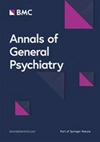双相情感障碍门诊患者离婚的现实预测因素:性别差异与临床意义
IF 3.6
3区 医学
Q1 PSYCHIATRY
引用次数: 0
摘要
躁郁症是一种以反复发作的躁狂和抑郁为特征的精神疾病,已知会导致社交障碍。此外,有研究表明,躁郁症会增加离婚和失去家人支持的风险,从而使预后恶化。然而,在现实世界中,有关双相情感障碍患者离婚预测因素的证据却很有限。本研究采用观察法,由日本神经精神科诊所协会的 176 家会员诊所的精神科医生参与。他们被要求对医疗记录进行回顾性审查,并填写一份以确诊为躁狂症患者为重点的调查问卷。患者基线特征的数据收集期为2017年9月至10月。接下来,我们调查了从基线到2019年9月至10月这2年间的离婚发生率。共有 1071 名双相情感障碍门诊患者被纳入分析,其中 2.8%(30/1071)的患者在观察的前 2 年中经历过离婚。该人群的离婚率大大高于日本普通人群。二项式逻辑回归分析证实,在所有研究参与者中,较年轻的基线年龄和较低的体重指数值在统计学上对离婚发生率有显著的预测作用。然后,按性别对离婚的预测因素进行了分别研究。结果显示,就男性而言,基线年龄较小、躁郁症 I 与躁郁症 II 相比,在统计学上对离婚有显著的预测作用。相比之下,对于女性来说,体重指数较低和使用抗焦虑药在统计学上对离婚有显著的预测作用。在这项研究中,较年轻的基线年龄和较低的体重指数值对双相情感障碍患者的离婚预测具有统计学意义。值得注意的是,预测离婚的因素在男性和女性之间存在显著差异。这些发现从家庭的角度为双相情感障碍患者在实际临床环境中的社会支持提供了重要的启示。本文章由计算机程序翻译,如有差异,请以英文原文为准。
Real-world predictors of divorce among outpatients with bipolar disorder: sex differences and clinical implications
Bipolar disorder is a mental illness characterized by recurring episodes of mania and depression and is known to cause social impairment. Additionally, it has been revealed that bipolar disorder increases the risk of divorce and loss of family member support, which can worsen the prognosis. However, there is limited evidence regarding the predictive factors of divorce among patients with bipolar disorder in real-world settings. This study utilized an observational approach and involved psychiatrists from 176 member clinics of the Japanese Association of Neuro-Psychiatric Clinics. They were requested to conduct a retrospective review of medical records and complete a questionnaire focused on patients diagnosed with bipolar disorder. The data collection period for baseline patient characteristics spanned from September to October 2017. Next, we investigated the incidence of divorce over a 2-year period, ranging from baseline to September to October 2019. A total of 1071 outpatients with bipolar disorder were included in the analysis, and 2.8% (30/1071) experienced divorce during the first 2 years of observation. The incidence of divorce in this population was considerably higher than that in the general Japanese population. Binomial logistic regression analysis confirmed that a younger baseline age and lower BMI values were statistically significant predictors of divorce occurrence for all study participants. The predictors of divorce were then examined separately by sex. The results revealed that for men, a younger age at baseline and having bipolar I disorder compared to bipolar II disorder were statistically significant predictors of divorce. In contrast, for women, having a lower BMI and using anxiolytics emerged as statistically significant predictors of divorce. In this study, a younger baseline age and lower BMI values were statistically significant predictors of divorce in patients with bipolar disorder. Notably, the predictors of divorce varied significantly between men and women. These findings provide important insights from a family perspective regarding social support for individuals with bipolar disorder in real-world clinical settings.
求助全文
通过发布文献求助,成功后即可免费获取论文全文。
去求助
来源期刊

Annals of General Psychiatry
PSYCHIATRY-
CiteScore
6.60
自引率
2.70%
发文量
43
审稿时长
>12 weeks
期刊介绍:
Annals of General Psychiatry considers manuscripts on all aspects of psychiatry, including neuroscience and psychological medicine. Both basic and clinical neuroscience contributions are encouraged.
Annals of General Psychiatry emphasizes a biopsychosocial approach to illness and health and strongly supports and follows the principles of evidence-based medicine. As an open access journal, Annals of General Psychiatry facilitates the worldwide distribution of high quality psychiatry and mental health research. The journal considers submissions on a wide range of topics including, but not limited to, psychopharmacology, forensic psychiatry, psychotic disorders, psychiatric genetics, and mood and anxiety disorders.
 求助内容:
求助内容: 应助结果提醒方式:
应助结果提醒方式:


